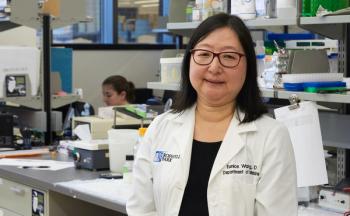
Systemic Therapy in BCC
The safety and efficacy of hedgehog inhibitors sonidegib and vismodegib are examined in the systemic treatment of BCC.
Transcript
Morgana Freeman, MD: The use of hedgehog inhibitors really relies on our understanding of how basal cell carcinoma [BCC] uniquely grows. Basal cell carcinoma relies on something called the smoothened pathway, and it’s essentially a protein receptor that sits on the extracellular surface. When activated, it sends downstream signals to activate DNA transcription and continued cell turnover and growth. When we learned that this smoothened pathway was very important to BCC development, growth, and possibly even subsequent metastasis, when we inhibit that pathway then, we can collapse the existing cancer growth but also prevent further cancer growth from later appearing. It’s a unique feature to basal cell carcinoma, and there are other growth pathways that it depends on. But that pathway in particular is the one that we exploit when we talk about therapies like sonidegib and vismodegib.
Omid Hamid, MD: At the time of the discovery of the hedgehog inhibitors for basal cell carcinoma, this was a significant finding because basal cell carcinomas historically had no systemic therapy. We knew that about 90% of these tumors had mutations in PTCH and smoothen. That indicated a hedgehog inhibitor would have a high efficacy, and that’s what we’ve seen. We have seen response rates as high as 50% to 60% in these patients. We’ve seen durations of response that are over 2 years in these patients. These patients previously had no clear options, no targeted therapy, and no systemic therapy, whether it was chemotherapy or otherwise.
Unfortunately, their main therapeutic options remained surgery and radiation, reirradiation, and surgery again. That led to significant morbidity, disfigurement, and also mortality. The hedgehog inhibitors were a panacea for our patients. They gave us great ability to control disease, and in certain subsets of patients—like those with Gorlin syndrome that have multiple tens of basal cell carcinomas yearly with high risks—we saw decreased incidence of basal cell carcinomas, the ability to control disease, and the ability to have less morbidity from therapeutic options.
Unfortunately, the adverse effects that we see with these hedgehog inhibitors are wide and varying, and they are unlike any toxicities we’ve seen. The main toxicities you see are dysgeusia, which is a loss of taste or a change in taste. That leads to patients not enjoying eating and having significant weight loss. Again, there’s also anorexia that you see with this drug. There is significant alopecia, or hair loss, that is not reversible in the majority of patients that I’ve seen, even after stopping the drug.
There are cardiac toxicities that you have to be aware of. The muscle cramping that I hear from patients is significant. We don’t have the ability to give a therapy that stops this muscle cramping well, but we have our anecdotal therapies like stretching before sleeping, keeping hydrated, and exercising. Patients have had diarrhea also. They have had peripheral edema seen with this. Nauseousness also comes with these drugs. As you can see, that’s a significant morbidity.
For my patients, we discuss the dosing of this drug because it is a once-a-day dosing. Pharmacokinetics do not allow you to decrease the dose of these drugs. You cannot dose them lower. You cannot dose them 1 day on and 1 day off. Historically there have been some forays into on and off dosing, which would be 2 weeks on, 1 week off, or a couple weeks on, a couple weeks off. Those are options for your patients who cannot tolerate continuous dosing.
For patients, I look at the benefits that they’re getting. I do think about drug holidays. We have extensive discussions about the toxicities, and I also ask them to go the websites for patients receiving these 2 drugs. There is a lot of help and support there.
Morgana Freeman, MD: Sonidegib and vismodegib are both considered first-line therapies for the management of locally advanced or metastatic basal cell carcinoma. The drugs are essentially interchangeable in terms of their adverse effect profile, as well as the outcomes that were seen on their pivotal trials. Because of some of the concerns about tolerability, especially for patients, and quality of life, we are looking at other therapies in an investigational sense to see if there are better systemic treatment options for BCC.
Newsletter
Stay ahead of policy, cost, and value—subscribe to AJMC for expert insights at the intersection of clinical care and health economics.








